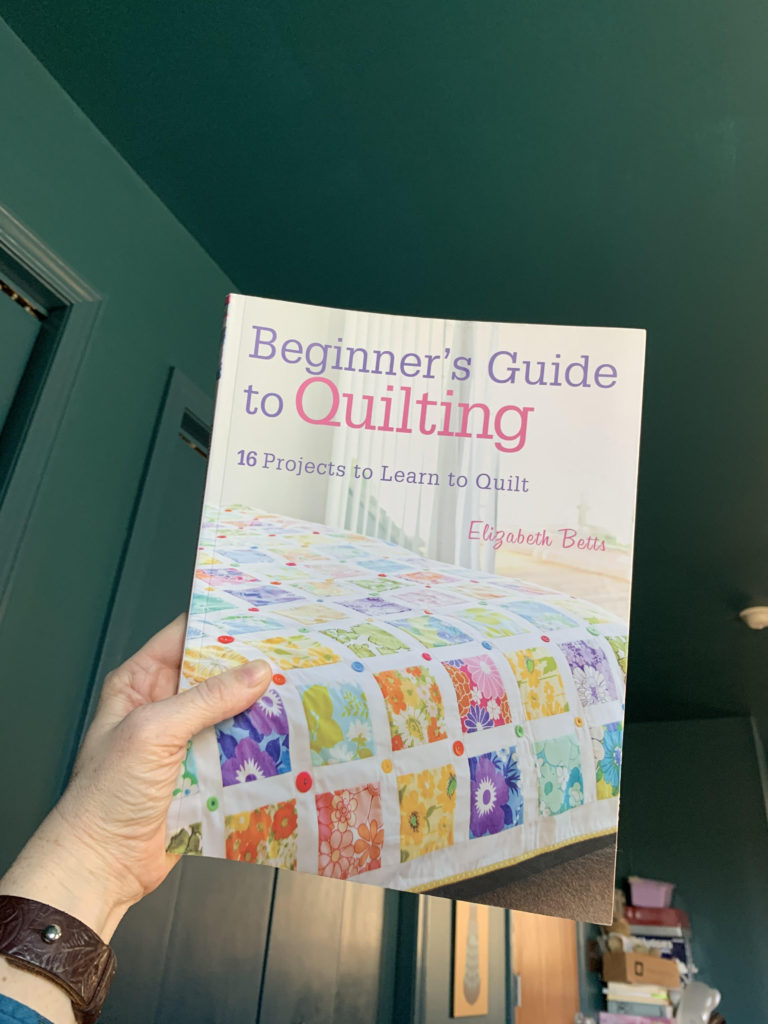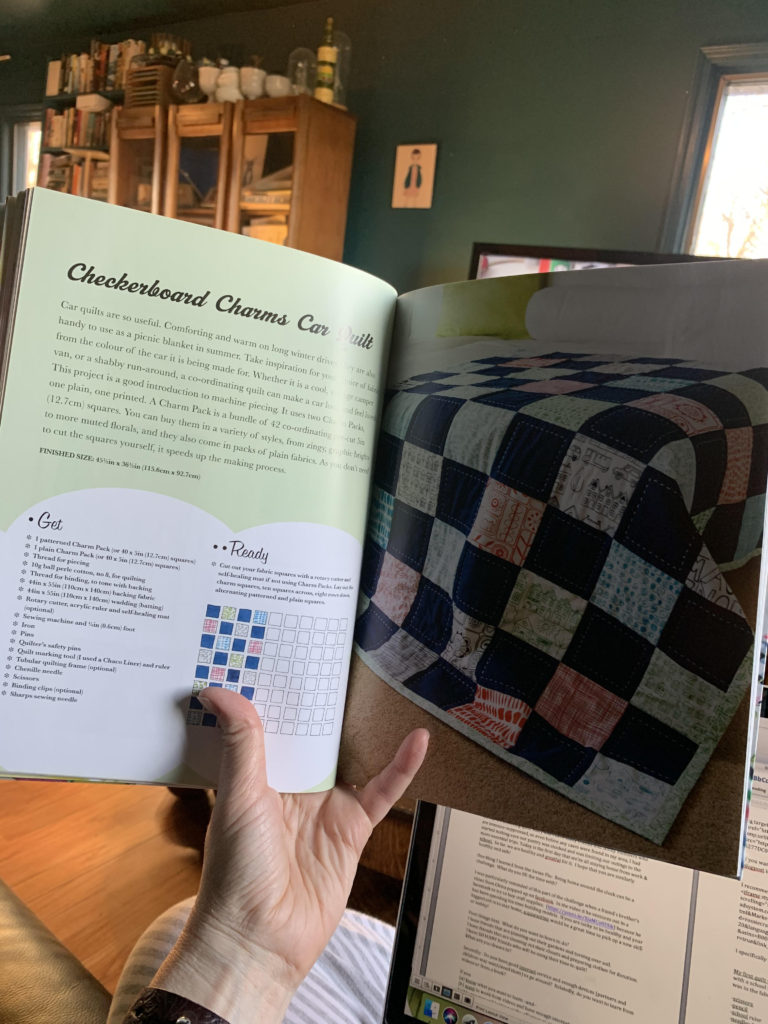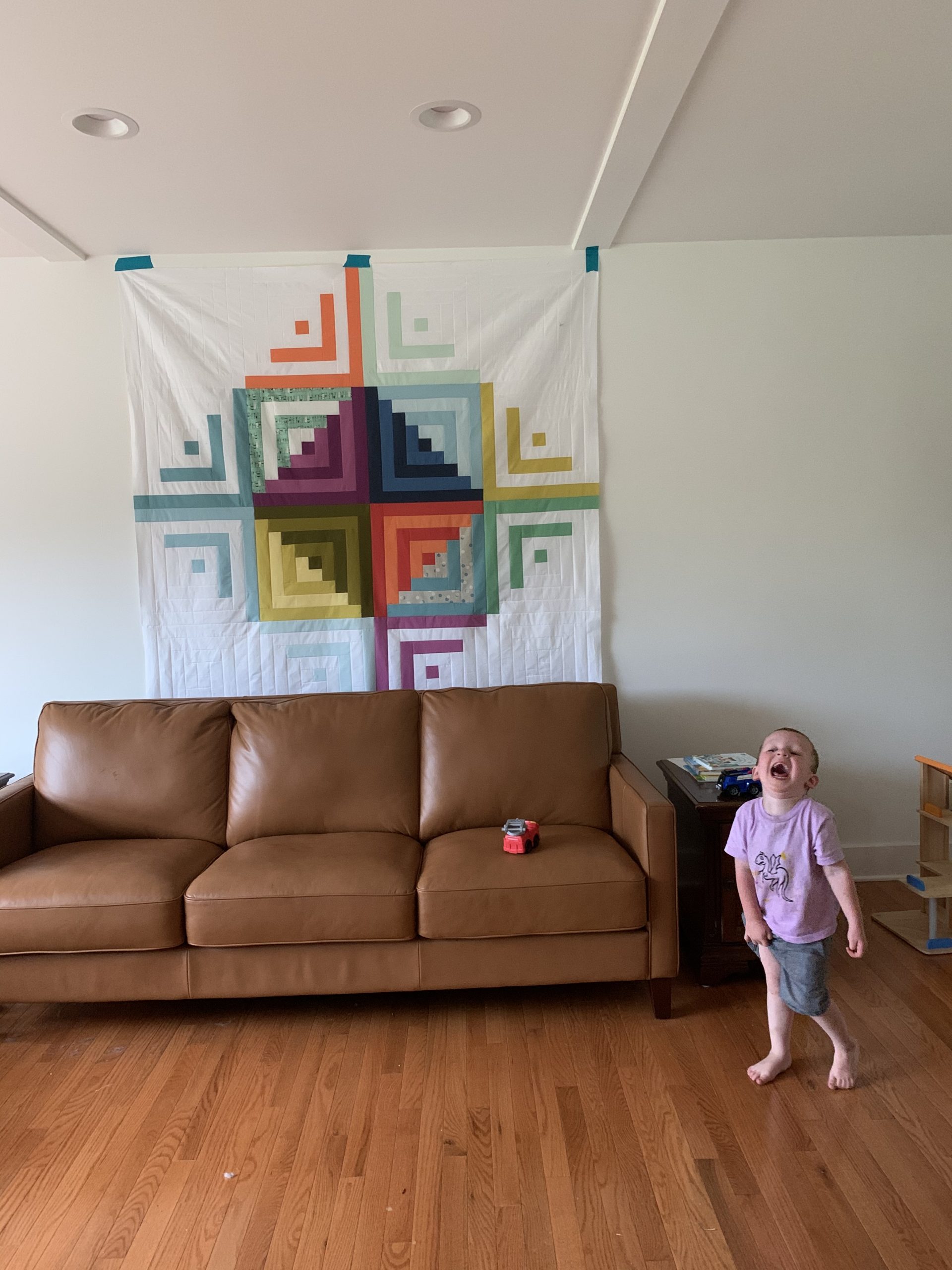I'm really pumped to be teaching at Quilt Con in February! SOFT CRITICISM - space…

Quarantine Quilting for Beginners
In 2009, I caught swine flu (H1N1) from a toddler I was nannying. My case was mild, but following the advice of the experts, I self-quarantined for a week. During that week, I became so explosively bored that I wrote the first drafts of 3/5ths of my dissertation. What I wrote would require extensive editing, as my fevered, solitude-crazed writing left holes all over the place. BUT! A first draft is more than half the battle for me. So that illness and quarantine did me some favors. I had my PhD within 6 months! Thanks, SWINE FLU!
COVID-19 is looking quite scary and I have many friends and family members who are immune-suppressed, so even before any cases were found in my area, I had started making sure our pantry was stocked and was limiting our outings to the more essential trips. Today is the first day that we’re all staying home from work & school. So far, we are healthy and greatful for it. I hope that you are similarly healthy and safe!
One thing I learned from the Swine Flu: Being home around the clock can be a challenge. What do you fill the time with?
I was particularly reminded of this part of the challenge when a friend’s brother’s video from China popped up on facebook. In the video it he ventures out in a facemask to try to buy craft supplies. (https://youtu.be/XJaMCuODIik) He has to restock because he has been spending his time building models. If you are lucky to be healthy and your biggest job is to stay home, a quarantine would be a great time to pick up a new skill or hobby! If your situation is more serious than this, please know that my heart is with you, 100%.
First things first: What do you want to learn to do?
- I have friends that are planning out their gardens and turning over soil.
- I have friends that are cleaning out their closets and preparing clothes for donation.
- I have SO MANY friends who will be using their time to quilt!
What are you drawn to?
Secondly: Do you have good internet service and enough devices (partners and children way want/need them) to go around? Relatedly, do you want to learn from videos or from a book?
If you
(a) know what you want to learn –and–
(b) want to work from videos and have enough internet and devices to go around, I highly recommend looking at the offerings at Creativebug. They have a huge variety of classes from excellent teachers and the cost is quite low! Less than Netflix!

If you want to learn to QUILT and you want to learn from a book, the rest of this blogpost is for YOU!
I recommend The Beginner’s Guide to Quilting by Elizabeth Betts for anyone who wants to learn to quilt:

I specifically recommend making the quilt on page 48. Checkerboard Charms Car Quilt. This quilt ends up being the size of a typical baby quilt. It’s good to start with simple patterns and smaller quilts!

SUPPLIES:
My first quilt was cut by scissors after tracing out shapes with a pencil, measured with a school ruler. My first quilt was sewn by hand. This means the total expense was in the fabric! And a few needles and some thread. EXTREMELY CHEAP over all!
THE VERY BASIC KIT:
Here’s what you need to gather or buy to work that way:
- Beginner’s Guide to Quilting by Elizabeth Betts
- scissors
- pencil & school ruler — use them to trace the squares on the back of your fabric, then cut with scissors!
- needles for hand-sewing
- thread
- fabric
- iron
- ironing board
- fabric (see separate listing below)
- quilt batting
A MORE NORMAL QUILT KIT:
Nowadays I measure and cut fabric using a rotary cutter, rotary ruler, and rotary cutting mat. I sew on a sewing machine.
- Beginner’s Guide to Quilting by Elizabeth Betts
- rotary cutter, acrylic ruler, self-healing cutting mat– the book explains how to use these!
- sewing machine
- sewing machine needles
- sewing machine thread
- iron
- ironing board
- fabric (see separate listing below)
- quilt batting
HOW TO GET WHAT YOU NEED:
You likely have some of these supplies in your home! An iron and some scissors sharp enough to cut fabric, perhaps? For the rest, consider asking around if anyone has extras that you can borrow. People who have been quilting for a while tend to have doubles of things. I know on my little rural road, there are several quilters and any of them could lend a machine and cutting system to a neighbor without any impediment to their own ability to sew! Depending on the precautions necessary given the presence (or not) of coronavirus in your area, they could leave supplies out for pick up, or you could visit a bit!
Also depending on what precautions you need, you could take the shopping list to your local quilting store (they also have a lot of these supplies at stores like Joanns, & Walmart, but I recommend starting at your local quilt shop because (a) it’s a smaller place with fewer people (i.e. it is safer) (b) that money will stay local and (c) they will have the best quality fabric.)
I’m going to post links to this stuff at Amazon at the end of this post as well, in case that is your preferred option.
THE FABRIC:
To make the Checkerboard Charms Quilt in her book , Betts recommends making this quilt by buying CHARM PACKS. Those are pre-cut 5-inch squares. She recommends buying one 40-piece charm pack of light fabric and one 40-piece charm pack of a dark solid. I’m not convinced this is as easy as she makes out. Charm packs aren’t readily sold at most stores. What I would recommend instead is a pack of fat-quarters which you can cut down into 5-inch squares, plus another yard of fabric (either light or dark, the opposite of what’s mostly in your chosen charm pack.)
Here’s my local store’s list of pre-cuts, including fat quarters and charm packs: Precuts and bundles at Pink Castle Fabric. They ship worldwide.
Here’s another online shop that has lots of pretty fat quarter packs to pick from and ships quickly: Fabric Bubb
And last but not least, this shop has a lot of the supplies you need in addition to the fabric, so it’s also worth a look (though the selection might be a bit overwhelming!) Hawthorne Supply Co.
FABRIC TO ORDER:
(1) a fat quarter bundle.
(2) another yard of fabric (look at the solid fabrics!)(or maybe you can buy a yard of one of the fabrics already in the bundle)
(3) 1.66 yards of a fabric to be the BACK of the quilt
note: you will have some leftover fabric.
my advice: buy fabric you love, even if it costs a few more dollars than ones you like
you might be able to GATHER fabric. any unstained bits of cotton or cotton-blend fabrics that have been washed a bunch of times and don’t’ have stretch in them should work in a quilt. If you live with someone (or are someone) who wears a lot of dress shirts or flannel shirts, you can ask them to clean out their closets. Some of my favorite fabrics came from backs/sleeves of my husbands shirts; they had stains on the neck and armpit that made them unwearable, but still had lots of usable unstained parts for my quilts!
For more on starting quilting without breaking the bank, check out my friend Laura’s advice!
Just in case it is easier for you, here is a list of supplies with link to them on Amazon:
| THE BASIC KIT | Amazon | price on 3/13 |
| Beginner’s Guide to Quilting by Elizabeth Betts | https://amzn.to/3aTGuhz | 16.50 |
| fabric scissors | https://amzn.to/2w3IQeZ | 18.50 (it’s a kit with snips, too!) |
| pencil | https://amzn.to/2U3IAET | 2.23 |
| school ruler | https://amzn.to/2wVTd4s | 0.47 |
| needles for hand-sewing | https://amzn.to/2U6mtgL | 3.64 |
| pins | https://amzn.to/3aU0xMW | 3.82 |
| pin cushion | https://amzn.to/2vVMPud | 7.93 |
| thread | https://amzn.to/2WbuNys | 9.46 |
| iron | https://amzn.to/2vjWKct | 16.99 |
| ironing board or pressing mat | https://amzn.to/2TLZuZF | 21.49 |
| fabric (see separate listing above) | ||
| batting, backing, and binding (see separate note below) |
| A MORE NORMAL QUILT KIT: | ||
| Beginner’s Guide to Quilting by Elizabeth Betts | https://amzn.to/3aTGuhz | 16.50 |
| fabric snips | https://amzn.to/2w3IQeZ | 18.50 (it’s a kit with fabric scissors, too!) |
| rotary cutter | https://amzn.to/2W70JnT | 20.39 |
| acrylic ruler | https://amzn.to/3cTBwDr | 6.99 |
| OR this larger acrylic ruler | https://amzn.to/2xDixN9 | 19.21 |
| self-healing cutting mat | https://amzn.to/2xtYEIa | 24.73 |
| OR this larger self-healing cutting mat | https://amzn.to/3aQJUSf | 29.97 |
| sewing machine (I am linking one here on Amazon that I own and enjoy. You just need a straight stitch for quilting so almost any machine will do. You can find machines at thrift stores and you may be able to borrow one from a friend. If you’d like to buy a machine, my friend Brenda has prices so good she can’t advertise them. Email admin@pinkcastlefabrics.com to ask about their Janome machines!) | https://amzn.to/2Wbx9NO | 329.00 |
| sewing machine needles | https://amzn.to/33e2l0C | 7.19 |
| sewing machine thread | https://amzn.to/2WbuNys | 9.46 |
| iron | https://amzn.to/2vjWKct | 16.99 |
| ironing board | https://amzn.to/2TLZuZF | 21.49 |
| pins | https://amzn.to/3aU0xMW | 3.82 |
| pin cushion | https://amzn.to/2vVMPud | 7.93 |
| fabric (see separate listing above) | ||
| batting, backing, and binding (see separate table below) | ||
| quilting supplies (see separate table below) |
BATTING, BACKING, and BINDING : You can order your batting and backing at the same time that you order your fabric. However, it’s common to work on making the fronts of the quilts (the patchwork) without putting everything together right away, so feel free to wait on those items if funds are low or you want time! Please also note that in the book, Betts wrote the pattern for Checkerboard Charms Quilt assuming you would hand quilt it. That’s what you should do if you don’t have a machine, but I recommend trying machine quilting if you do have a machine! Also, Betts recommends self-binding. I suggest that you do a mitered double-fold binding, which she explains on p. 28.
| BATTING, BACKING, BINDING | ||
| batting | https://amzn.to/38M6NEL | 10.71 |
| backing | 1.5 yards of quilting fabric | |
| for mitered double-fold binding | 0.5 yards of fabric |
| FOR HAND QUILTING | ||
| perle no.8 for quilting | https://amzn.to/2WaQKhl | 6.99 |
| chenille needle | https://amzn.to/39Rzm50 | 4.09 |
| quilter’s safety pins | https://amzn.to/3d0231C | 6.99 |
| tubular quilting frame | https://amzn.to/33hGaXf | 15.19 |
| FOR MACHINE QUILTING | ||
| Walking foot (optional) you may want to try a walking foot on your machine. You might already have one. To buy one, you need to know what kind of machine you have to find the right one for it. Honestly, I’m not a big fan of walking feet–try a little test quilting without it! | depends on your machine | usually 50 or so |
| quilter’s safety pins | https://amzn.to/3d0231C | 6.99 |
| thread | use the same thread as you used to make the quilt top! Maybe in a fun color! | |
Please ask any questions in the comment here! I will be checking back in as I can!
*some links are affiliate links. This means I get a few pennies if you use them, at no cost to you!
This Post Has One Comment
Comments are closed.



We haven’t gone into lockdown Down Under yet, but if it happens, I have enough scraps to use up to last me several years and the perfect excuse to do it. I might need to lay in a little extra thread, though… I’m also teaching a local friend to quilt, so I might have to see if she needs any supplies I can lend. Thank you for that suggestion.